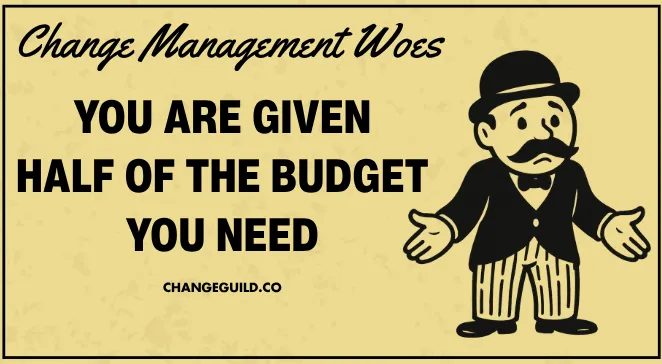A field guide to reengaging skeptics with the right metrics at the right moment.
You know the feeling.
The nods are slower. The cameras start going off. Stakeholders begin deferring updates or quietly shifting their priorities. Buy-in—once secured—is starting to wobble.
And if you're like most change practitioners, your first instinct might be to lean harder on storytelling, send another status deck, or put together a town hall. But sometimes what’s needed isn’t more visibility. It’s precision. And that means showing the right data at the right time to the right people.
This article offers a field-ready guide to doing just that.
The Moment Buy-In Wobbles
Losing buy-in rarely announces itself with a bullhorn. It shows up as:
- Delayed decisions
- Missed meetings
- Executive “parking lot” comments
- Passive-aggressive skepticism about “how ready the org really is”
These aren’t just nuisances—they’re signals. If you’re seeing them, it’s time to pivot. What these moments often demand isn’t more enthusiasm, but sharper metrics. Done well, a single compelling data point can do what five status updates never will: shift the narrative.
The Four Types of Data That Rebuild Buy-In
Let’s make this practical. Not all data is created equal, and not all resistance is the same. Reengaging a skeptical CFO requires a different approach than winning over a disengaged regional director.
Here are four types of data to have in your back pocket:
1. Credibility Data
Used to prove that something is happening.
This includes things like:
- Number of teams trained or onboarded
- Volume of communications sent and opened
- Completion rates for key milestones
- Volume of user feedback or survey responses
Use when people are questioning whether the change is real or moving forward at all.
2. Confidence Data
Used to prove that it’s working.
Think:
- Adoption curves
- Usage rates (log-ins, system usage)
- Qualitative feedback that shows behavior change
- Pre/post metrics on process speed, error reduction, etc.
Use when the question is “Is this worth it?” or “Are we actually seeing results?”
3. Consequences Data
Used to show what happens if we stop now.
Examples:
- Risk forecasts or compliance penalties
- Support ticket surges in legacy systems
- Delays in downstream initiatives
- Employee turnover in impacted functions
Use when the alternative to change is mistakenly assumed to be neutral or cheaper.
4. Comparative Data
Used to show what others are doing.
Options include:
- Peer benchmarks
- Internal performance comparisons (Team A vs Team B)
- Industry trend lines
- Voice-of-customer expectations vs internal readiness
Use when stakeholders respond better to external validation or competitive fear.
Mapping the Data to the Doubter
Let’s break it down even further. Here are three common “wobbler” profiles—and what kind of data usually unlocks them:
The Analytical Exec
Concern: “This change sounds soft. Where’s the business case?”
Use: Comparative + Consequences
What to show: Cost of delay models, competitor success stories, resource waste in the current state
The Overwhelmed Manager
Concern: “My team doesn’t have time for this.”
Use: Confidence + Credibility
What to show: Early wins from pilot teams, efficiency gains, change fatigue stats they can relate to
The Passive Resistor
Concern: “This won’t affect my area.”
Use: Credibility + Consequences
What to show: Direct impact on their team's KPIs, user feedback from their peers, what’s already been decided and is moving
How to Deliver the Message (Without Getting Ignored)
Let’s say you have the right data. The next step is avoiding two critical mistakes:
- Dumping it in a dashboard
- Dashboards can be useful, but they rarely tell a story. They need interpretation.
- Pro tip: Pick one compelling metric and contextualize it in 2–3 sentences.
- Waiting for the perfect moment
- Timing matters—but don’t hoard the data waiting for the next all-hands.
- Instead, insert your datapoint into already scheduled conversations:
- A leadership sync
- A project status email
- A 1:1 or skip-level
When in doubt, create a crisp, well-labeled one-pager. The more visual, the better. Use arrows, thresholds, trendlines. Your job is not to share more data. It’s to help people see what it means.
A Quick Win Playbook
If you’re losing buy-in, here’s a fast diagnostic:
Ask yourself:
- Who’s starting to disengage or show signs of resistance?
- What’s their likely reason? (Overload? Skepticism? Self-preservation?)
- Which of the four data types aligns with that mindset?
- Where is that data already available—or easy to extract?
- What’s the next conversation or touchpoint where I can slip it in?
Pitfalls to Avoid
Before you rush to add five charts to your next update deck, a warning:
- Avoid vanity metrics. Just because 100 people clicked a link doesn’t mean anything changed.
- Don’t cherry-pick. Smart stakeholders will see through selective data. Show the full picture—especially if there’s still work to do.
- Don’t use data as a cudgel. Your goal is to reengage, not corner. Use metrics to spark conversation, not to prove someone wrong.
Final Thought
In moments of fading buy-in, data becomes more than just a report—it becomes a flashlight. When used well, it doesn’t just show what’s happening. It shows why it matters and what’s next.
The best change practitioners aren’t just good storytellers. They’re skilled at surfacing the right facts at the right moment—helping leaders and teams see the signal in the noise.
ChangeGuild: Power to the Practitioner™
Frequently Asked Questions
What are the four types of data that help rebuild stakeholder buy-in?
The four types are: Credibility data (to prove progress is happening), Confidence data (to show it’s working), Consequences data (to illustrate risks of not acting), and Comparative data (to benchmark against others).
When should I use Confidence data instead of Credibility data?
Use Confidence data when stakeholders doubt the value or outcomes of the change. Use Credibility data earlier, when people are questioning whether anything is actually happening.
What’s a common mistake when sharing metrics with skeptical stakeholders?
One major mistake is overwhelming them with dashboards instead of curating a single, contextualized datapoint that supports a clear narrative. Another is relying on vanity metrics that look good but don’t prove impact.
How do I know which data type to use for a disengaged stakeholder?
Start by diagnosing their mindset. If they’re indifferent, use Credibility or Consequences data to show that action is already underway—and that there are implications if ignored. Tailor your choice to their likely concern.
Can these data types be used in status reports or only presentations?
Absolutely. These data types work well in status reports, leadership syncs, emails, and even casual check-ins. The key is when and how you introduce them—not just where they appear.
Want help reframing the conversation when buy-in starts to slip?
If you’re tired of pushing dashboards that don’t move the needle—or feeling like your updates vanish into the void—we help change leaders craft the right message at the right moment. Let’s get your strategy aligned with what your stakeholders actually need to see.
This post is free, and if it supported your work, feel free to support mine. Every bit helps keep the ideas flowing—and the practitioners powered. [Support the Work]








